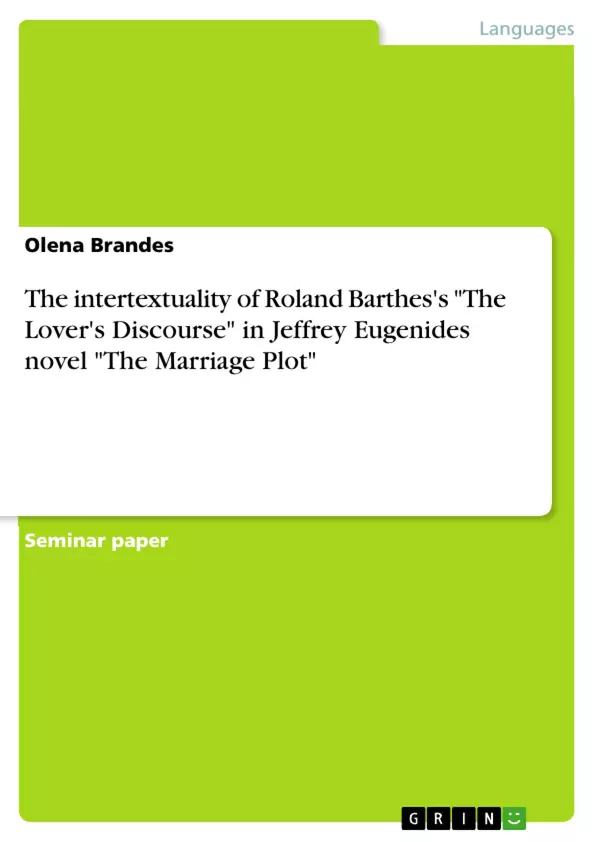The aim of this paper is to explore the different intertextual links between the two literary works. While the main character Madeleine deconstructs Barthes's deconstruction of love in her term paper and applies it to her own life, the narrator deconstructs Madeleine's love life and this paper should deconstruct the narration’s deconstruction of the relationship.
If the concept of love is to be seen as an architectural building consisting of a foundation, roofs, walls, floors, stairs, openings, standing in a specific location and having a personal interior design, it can be disassembled into its individual parts. Even though most buildings are different and fewest are identical, they all share the same basic elements they are built of. The French philosopher Roland Barthes breaks down the concept of love into its fragments in his work "A Lover's Discourse" (1977). 34 years later, the American novelist Jeffrey Eugenides publishes a romance novel, "The Marriage Plot" (2011), where Barthes's fragments are a reference point to the narrator. Some of these fragments are direct quotes, but most remain unsaid, lying under the surface.
Finding all fragments would go beyond the constraints of this paper. Thus, the focus should be on only a few fragments. In particular, focusing on the most prominent main character’s perspective, while the plot contains two more discourses on love from the main character's love interests.
Inhaltsverzeichnis (Table of Contents)
- Introduction
- About Roland Barthes' „A Lover's Discourse Fragments“
- About Jeffrey Eugenides' „The Marriage Plot“: love seen through the lense of text
- Analysis of Intertextuality: Barthes' Fragments in Eugenides' The Marriage Plot
- „I am crazy“ (fou / mad)
- Agony (angoisse / anxiety)
- The Absent One (absence/absence)
- Identifications (identification / identification)
- Exuberance (dépense / expenditure)
- Fade-out (fading / fade-out)
- The Other's Body (corps / body)
- Atopos (atopos / atopos)
- Blue Coat and Yellow Vest (habit / habiliment)
- Flayed (écorché / flayed)
- The Tip of the Nose (altération / alteration)
- Solitude
- Waiting (attente / waiting)
- Dark Glasses (cacher / to hide)
- ,,Special Days“ (fête / festivity)
- Ravishment (ravissement / ravishment)
- ,,How blue the sky was“ (rencontre / encounter)
- Love's Obscenity (obscène / obscene)
- I Love You
- Catastrophe (catastrophe / catastrophe)
- In Praise of Tears (pleurer / crying)
- To Love Love (annulation / annulment)
- Regretted?
- Exiled from the Image-repertoire (exil / exile)
- ,,I am odious“
- ,,I have an Other-ache“
- The Orange (fâcheux / irksome)
- Truth (vérité / truth)
- Conclusion
Zielsetzung und Themenschwerpunkte (Objectives and Key Themes)
This paper explores the intertextual connections between Roland Barthes' "A Lover's Discourse" and Jeffrey Eugenides' "The Marriage Plot." The author examines how Barthes' fragmented analysis of love influences the main character's perspective and the narrative of Eugenides' novel.
- Intertextuality of "A Lover's Discourse" in "The Marriage Plot"
- Deconstruction of love through the lens of Barthes' fragments
- Analysis of different perspectives on love in the novel
- The role of language and communication in love
- The impact of semiotics and textuality on understanding love
Zusammenfassung der Kapitel (Chapter Summaries)
The introduction sets the stage by comparing the concept of love to an architectural building, emphasizing the universal elements that constitute it, even if different buildings appear unique. It introduces both Barthes' "A Lover's Discourse" and Eugenides' "The Marriage Plot" as works that explore these fundamental elements of love.
The "About Roland Barthes' „A Lover's Discourse Fragments“" section delves into the nature of Barthes' work, describing it as a fragmented diary rather than a formal philosophical text. It highlights the first-person narration and the emphasis on solitary inner discourse. The section explains how Barthes' "figures" represent snapshots of the lover's internal state, reflecting a momentary amorous feeling.
The "About Jeffrey Eugenides” „The Marriage Plot“: love seen through the lense of text" section focuses on how Madeleine, a character in Eugenides' novel, interprets love through a textual lens, potentially hindering her ability to develop a unique and dynamic personal relationship.
The "Analysis of Intertextuality: Barthes' Fragments in Eugenides' The Marriage Plot" section, which is not covered in this preview due to its length and potential for spoilers, likely delves into a detailed examination of specific fragments from Barthes' work and their presence, both overt and underlying, in Eugenides' novel.
Schlüsselwörter (Keywords)
This paper focuses on the intersection of literary theory, philosophy, and fiction. Key terms include intertextuality, deconstruction, "A Lover's Discourse," "The Marriage Plot," love discourse, fragments, semiotics, and communication.
- Quote paper
- Olena Brandes (Author), 2021, The intertextuality of Roland Barthes's "The Lover's Discourse" in Jeffrey Eugenides novel "The Marriage Plot", Munich, GRIN Verlag, https://www.hausarbeiten.de/document/1267861


